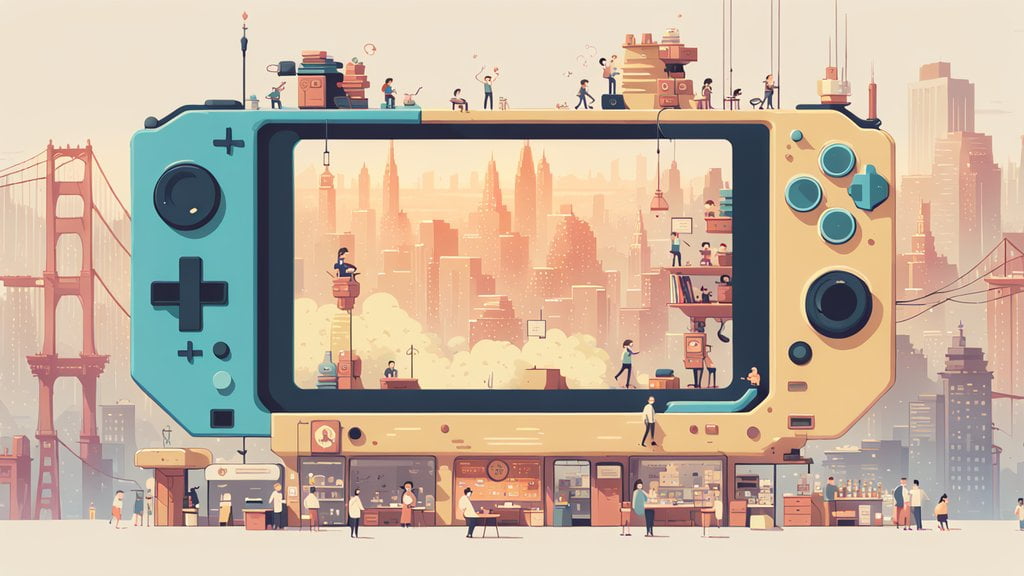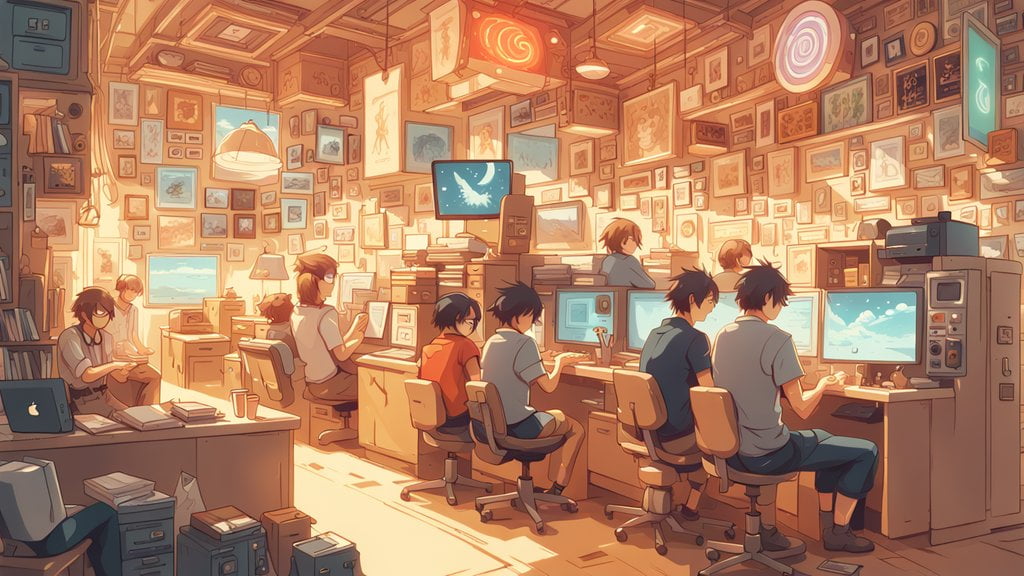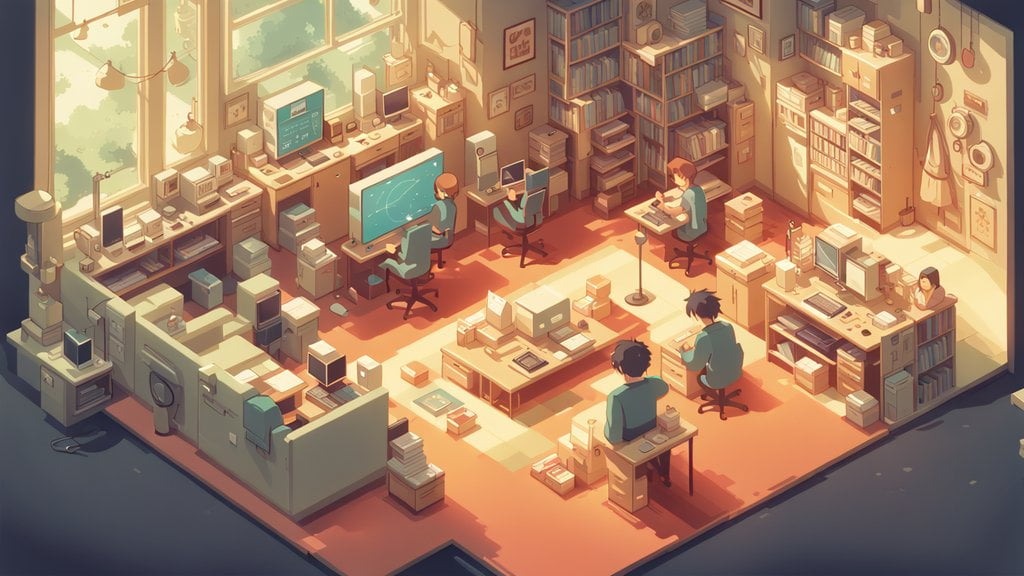Get ready to dive into the captivating world of video game designers with our article on “Fascinating Fun Facts: Exploring the Minds of Video Game Designers.” From lesser-known tidbits about their creative processes to their remarkable struggles and successes, we unveil intriguing insights into the minds behind your favorite video games. As an experienced gaming journalist, I bring a deep understanding of the industry to shed light on the fascinating world of video game designers. So, buckle up and prepare to embark on a journey that will leave you amazed by the brilliance of these masterminds.

Key Takeaways:
- Video game designers specialize in different areas of game design as they discover their preferred and most proficient areas.
- Coming up with engaging ideas can be a challenging step in video game design.
- Some popular video games include Final Fantasy, Pac-Man, Civilization, Lara Croft, and Pokemon.
- The first video games were created in the 1950s and 1960s.
- Grand Theft Auto V holds the record for the most expensive video game design, costing $265 million.
- Music plays a significant role in video game design.
Sources:
1. 15 Interesting Video Game Designer Facts by gamedesignlounge.com
– Provides facts about different types of game designers and the time it takes to develop games.
2. 9 Interesting Facts About Video Game Design You Didn’t Know by New Jersey Institute of Technology
– Offers facts about video game design schools, average age and salary of designers, and the worth of the industry.
These sources provide additional insights into video game design and complement the mentioned facts.
Fun Facts About Video Game Designers
Different Types of Game Designers
Did you know that there are several different types of game designers? These talented individuals usually specialize in specific areas as they learn what they enjoy and excel at the most. Some focus on level design, creating captivating and challenging environments for players to explore. Others specialize in character design, bringing to life the memorable heroes and villains we encounter in our favorite video games. Whether it’s gameplay mechanics, narrative development, or sound design, each type of game designer contributes their unique expertise to the overall gaming experience.
The Challenges of Idea Generation
Coming up with an engaging idea is a crucial but often challenging step in video game design. Game designers need to find a balance between innovation and familiarity, creating experiences that captivate players while still feeling accessible. It can be a creative rollercoaster as they brainstorm concepts, discard ideas that don’t quite work, and refine their visions to deliver memorable gaming experiences.
Popular Video Games and their Designers
When we think of video games, certain names immediately come to mind. From the epic fantasy realms of Final Fantasy to the iconic maze-chasing Pac-Man, these games have captured our imaginations for decades. They are products of the incredibly talented video game designers who brought them to life. Other beloved titles, such as Civilization, Lara Croft, and Pokemon, have also left indelible marks on the gaming industry, thanks to the dedication and creative prowess of their designers.
The Evolution of Video Game Design
Video game design may be a modern phenomenon, but its roots can be traced back to the 1950s and 1960s. During this time, early pioneers in computer technology laid the groundwork for what would become the rich and diverse world of video games we know today. These early forays into game creation set the stage for the innovation and evolution that continues to shape the industry.
The Cost of Creating Games
Creating a video game is no small task, and it often comes with a hefty price tag. One notable example is Grand Theft Auto V, which holds the title for the most expensive video game design to date. This blockbuster game cost a staggering $265 million to make, a testament to the scale and ambition of modern game development. The investment required reflects the complexity involved in creating immersive worlds, lifelike characters, and engaging gameplay experiences.
The Role of Music in Game Design
Music plays a vital role in video game design, setting the tone and enhancing the overall experience. It can create a sense of tension during intense moments, evoke emotions during heartfelt scenes, or provide an adrenaline-pumping soundtrack to epic battles. Game designers work closely with composers and sound designers to craft soundscapes that complement and elevate the gameplay, fostering a deeper connection between players and the virtual worlds they explore.
For more intriguing and enlightening fun facts about video game designers, check out the following sources:
- 15 Interesting Video Game Designer Facts by gamedesignlounge.com
- This article presents a range of facts about video game designers, including information on different types of game designers and the time it takes to develop fully functioning games.
- 9 Interesting Facts About Video Game Design You Didn’t Know by New Jersey Institute of Technology
- Explore this source to discover fascinating facts about video game design, such as the number of video game design schools worldwide, the average age and salary of video game designers, and the worth of the video game industry.
These sources will provide additional insights into the field of video game design and complement the fun facts mentioned above. So dive into the incredible world of video game designers and uncover more astonishing facts that highlight their expertise, innovation, and creativity.
For some fascinating fun facts about Kit Kats, click here.
Curious about the color blue? Discover interesting trivia and facts by clicking here.
Explore intriguing details about farm animals by clicking here.
Surprising Inspirations Behind Popular Video Games
Key Takeaways:
– Video game designers often find inspiration for their games in unexpected places, such as art history and cultural influences.
– The creative process for developing popular video games can involve moments of relaxation and outside-the-box thinking.
– The video game industry is a highly lucrative and growing field, with numerous educational resources available for aspiring designers.
Did you know that the best ideas for video games often come during moments of relaxation, such as bathing or taking a walk? It’s true! Many video game designers find their inspiration in unexpected places. In this article, we’ll explore some surprising inspirations behind popular video games and gain insights into the creative minds of video game designers.
One fascinating aspect of the video game industry is the sheer number of educational resources available for aspiring designers. With over 2,000 video game design schools worldwide, individuals interested in game design have numerous opportunities to learn and develop their skills. While a bachelor’s degree is helpful, it is not always required, as talent and creativity are highly valued in this field.
The median yearly salary for a video game designer is an impressive $90,000, and the job market is expected to continue growing. This lucrative industry is worth over $100 billion and consistently brings in more money than the film and music industries combined. Rockstar Games, known for creating some of the most financially successful games of all time, is a testament to the profitability of the video game industry.
Now, let’s dive into the surprising inspirations behind popular video games. Did you know that video games often draw inspiration from art history? Just like traditional artists, video game designers are influenced by different styles, techniques, and movements. From surrealist painters to abstract expressionists, various artists have left their mark on the digital realm.
One example of this artistic influence can be seen in the widely successful game Minecraft. This iconic game, which has sold over 200 million copies, draws inspiration from the concept of cubism. The blocky and pixelated graphics resemble the fragmented shapes found in cubist art, creating a visually unique and recognizable game.
Beyond art history, video games can also draw inspiration from cultural events. For instance, following World War II, South Korea put a ban on Japanese cultural imports. This led to the creation of the Nintendo Comboy, a console that combined the functionalities of a television and a gaming system. This example highlights how historical events can shape the development of video games and gaming culture.
Another surprising inspiration behind popular video games is the world of folklore. The Flight Simulator series, for instance, has become a place for emergent folklore. Players have created their own myths, legends, and stories within the game, turning it into a virtual realm full of mystery and wonder. This shows how video games can transcend their original purpose and become platforms for imaginative storytelling.
As we can see, video game designers are constantly pushing the boundaries of creativity and finding inspiration in the world around them. Their ability to take unexpected influences, such as art history and cultural events, and transform them into immersive gaming experiences is truly remarkable.
In conclusion, the fascinating world of video game design holds many surprising inspirations behind popular games. From drawing inspiration from art history to embracing cultural events and even becoming platforms for folklore, video game designers continually challenge our expectations and redefine the possibilities of interactive entertainment.
Sources:
– 15 Interesting Video Game Designer Facts by Game Design Lounge
– 9 Interesting Facts About Video Game Design You Didn’t Know by NJIT Online
Eccentricities and Unique Quirks of Video Game Designers
Have you ever wondered what goes on in the minds of video game designers? These creative geniuses are responsible for bringing our favorite virtual worlds to life. From crafting breathtaking landscapes to developing innovative gameplay mechanics, video game designers possess a unique combination of skills and quirks that make them stand out in the industry. In this article, we’ll dive deep into the eccentricities and unique quirks of video game designers, shedding light on what makes them tick.
Key Takeaways:
- Video game designers are a diverse group, each with their own specialization and unique approach to game development.
- Creativity is at the heart of video game design, and designers often draw inspiration from a wide range of sources, including music, art, and cultural events.
- Experimentation and outside-the-box thinking are key aspects of game design, leading to groundbreaking ideas and innovative gameplay mechanics.
- Collaboration and teamwork are essential for game designers, as they work closely with artists, programmers, and other professionals to bring their vision to life.
- The video game industry is a thriving field, offering lucrative career opportunities for passionate individuals with a love for gaming and technology.
As we delve into the fascinating world of video game designers, we uncover a diverse and intriguing range of personalities. Some designers have a penchant for creating fantastical worlds, while others excel at developing intricate puzzle mechanics. From their eccentricities to their unique quirks, let’s explore what makes these designers so captivating.
Designers and Their Fascinating Quirks
1. The Master of Mysteries
Have you ever played a game and found yourself engrossed in its compelling storyline, unable to put it down? Well, many game designers have a knack for weaving complex narratives that draw players into immersive gaming experiences. These designers are masters at crafting intricate mysteries, leaving players guessing until the very end. Their ability to create suspense and intrigue within a virtual world is truly remarkable.
2. The Artistic Visionary
Video games are a form of art, and some designers go above and beyond to create visually stunning masterpieces. These designers possess a keen eye for aesthetics and are often inspired by various art forms, from traditional painting to modern sculptures. They infuse their games with breathtaking visuals that transport players to mesmerizing worlds filled with vivid colors and breathtaking landscapes.
3. The Puzzle Whisperer
If you’ve ever struggled to solve a challenging puzzle in a video game, you can appreciate the genius of puzzle game designers. These individuals have an innate talent for creating mind-bending puzzles that require both logic and creative thinking to solve. With their intricate level designs and innovative puzzle mechanics, they keep players scratching their heads while experiencing the thrill of overcoming difficult obstacles.
4. The Sound Magician
Music plays a significant role in shaping the gaming experience, setting the tone and enhancing the emotional impact of a game. Video game designers with a passion for sound design and composition are akin to magicians, creating mesmerizing soundscapes that transport players to different realms. Their ability to evoke emotions through carefully crafted soundtracks is truly awe-inspiring.
5. The Technological Wizard
Behind every fantastic video game lies a brilliant technological mind. These designers excel at harnessing the power of cutting-edge technology to create immersive gaming experiences. Whether it’s developing complex physics engines or integrating virtual reality elements, they constantly push the boundaries of what is possible, introducing players to new and exciting gaming frontiers.
In Conclusion
Video game designers are a fascinating group of individuals with their own unique quirks and eccentricities. From crafting compelling narratives to creating visually stunning worlds, they possess a diverse range of talents and skills that contribute to the immersive experiences we enjoy as gamers. Whether you’re enthralled by intricate puzzles or mesmerized by breathtaking soundtracks, video game designers continue to inspire us with their creativity and ingenuity.
Citations:
- Game Design Lounge: Source
- CareerExplorer.com: Source
- Online.njit.edu: Source
- TheGamer.com: Source
Notable Collaborations between Video Game Designers and Other Industries
Collaboration is a key aspect of the video game industry, as developers often join forces with professionals from various fields to create innovative and captivating gaming experiences. In this article, we’ll explore some notable collaborations between video game designers and other industries that have resulted in groundbreaking and memorable games.
Collaboration as a Catalyst for Innovation
Collaboration among game designers is crucial as it facilitates the exchange of ideas, skills, and perspectives. By working together, they can push the boundaries of what’s possible in game design and merge different art forms to create unique experiences.
One remarkable collaboration that exemplifies this spirit is the partnership between video game giant Nintendo and the toy company LEGO. The result of this collaboration is the interactive video game “LEGO Dimensions,” which seamlessly combines physical LEGO blocks with digital gameplay. By merging physical play with virtual worlds, the collaboration brings a new level of immersion and creativity to both mediums.
Source: Game Rant
Blurring the Lines between Gaming and Music
The video game industry has a long history of collaborating with musicians and music producers to create memorable soundtracks. However, some collaborations go beyond creating music for games and delve into exploring new ways to integrate audio and gameplay.
One notable collaboration in this regard is the partnership between game designer Tetsuya Mizuguchi and musician Hiroshi Kawaguchi. Together, they created the critically acclaimed game “Rez,” which combines vibrant visuals and electronic music to create a mesmerizing synesthetic experience. This collaboration showcases how the fusion of music and gaming can result in a truly unique and immersive audiovisual journey.
Crossing Boundaries with Film and Television
Video game designers have also ventured into collaborations with the film and television industry, finding ways to merge storytelling techniques and visual aesthetics.
An exceptional example of this is the collaboration between game designer Quantic Dream and acclaimed actor Willem Dafoe in the game “Beyond: Two Souls.” Dafoe’s performances were captured using motion-capture technology, allowing his nuanced acting to bring the game’s characters to life. This collaboration illustrates how the merging of talents from the gaming and film industries can create compelling narratives and immersive experiences.
The Power of Cross-Industry Collaborations
Notable collaborations between video game designers and other industries demonstrate the power of creativity and interdisciplinary partnerships in game development. By joining forces, professionals from various fields can push the boundaries of innovation, create captivating experiences, and inspire new approaches to game design.
Key Takeaways:
- Collaboration is essential in the video game industry, as it allows game designers to merge different art forms and skills to create unique gaming experiences.
- Collaborations with industries such as toy companies, music, and film can result in groundbreaking and immersive games.
- The combination of physical and virtual elements, as seen in the partnership between Nintendo and LEGO, brings new levels of immersion to gaming.
- Collaborations between game designers and musicians can result in memorable soundtracks and synesthetic experiences.
- Partnerships with film and television industries can enhance storytelling techniques and visual aesthetics in video games.
Citations:
– Game Rant: Best Video Game Collaborations and Crossovers in 2021

FAQ
Q1: What are some different types of game designers?
A1: Some different types of game designers include level designers, gameplay designers, narrative designers, and character designers. Each specialization focuses on a specific aspect of game design.
Q2: How long does it typically take to develop a fully functioning video game?
A2: It typically takes 2 to 5 years to develop a fully functioning video game. This timeframe allows for the extensive planning, designing, programming, testing, and polishing required to create a high-quality game.
Q3: What is the median yearly salary for a video game designer?
A3: The median yearly salary for a video game designer is $90,000. This figure can vary based on factors such as experience, specialization, location, and the size of the game development studio.
Q4: Are there any interesting collaborations or crossovers between different video game franchises?
A4: Yes, there have been several interesting collaborations and crossovers between different video game franchises. Examples include Kingdom Hearts X Super Smash Bros. Ultimate and Monster Hunter Rise X Mega Man. These collaborations bring together iconic characters and elements from different games to create unique and exciting experiences.
Q5: What is the worth of the video game industry?
A5: The video game industry is worth over $100 billion. This significant value highlights the industry’s popularity and financial success, surpassing the combined worth of the film and music industries.
- Star Ring Trends: Etsy vs Amazon - March 28, 2025
- Boost Pollinator Habitats: Baby Blue Eyes Sustainable Farming Guide - March 28, 2025
- Protect Big Black Bears: Effective Conservation Strategies - March 28, 2025
















